A mobile light air defense system with a turret mounted on a tracked vehicle carrying four ready-to-fire missiles, the CHAPARRAL is a ground launched version of the air-to-air SIDEWINDER. CHAPARRAL is the Army's standard, short range, low altitude air defense system which provides point defense of vital corps areas against direct air attack. It homes in on the heat given off by the target aircraft's engine exhaust. Used against helicopters and low flying fixed-wing jets, this system is made by Loral Aerospace Corporation at a cost of $80,000 per missile and $1.5 million per fire unit. Although U.S. forces have never fired this missile in combat, the system has been successfully used under such conditions by allies of the United States. Based on a December 1994 decision, CHAPARRAL is being deactivated and removed from the U.S. Army National Guard inventory. This action will be completed by the end of FY 1997.
The Forward Area Alerting Radar (FAAR) was a D-band pulse doppler radar used to detect low flying aircraft and provide alerting and tentative identification to CHAPARRAL and VULCAN fire units and Manportable Air Defense (MANPAD) teams. The radar had a range of about 20 kilometers, contained the Mark XII Identification, Friend or Foe (IFF) system, and transmitted digital data to the target alerting data display sets (TADDS) located with each CHAPARRAL/VULCAN battalion. The FAAR section consisted of three men and one vehicle and trailer.

System Chronology
16 September 63 AMC directed MICOM to conduct studies and tests on the feasibility of adapting the Navy's SIDEWINDER 1C air-to-air missile for surface-to-air use.
30 September 64 The FAAR program was approved. The system was designed to provide early warning target information to CHAPARRAL and VULCAN fire units as well as REDEYE teams.
December 64 The Secretary of Defense approved the possible CHAPARRAL for further study & military potential tests.
27 January 65 MICOM forwarded the SIDEWINDER 1C/CHAPARRAL study & test results to AMC. The results indicated that such a system was feasible, but MICOM recommended that limited firing tests should be conducted to verify the predicted performance.
August 65 A MICOM report concluded that the CHAPARRAL system concept was feasible and could be fielded within the required time frame. The basic system concept consisted of a tracked vehicle, mount launcher & SIDEWINDER missiles.
25 April 66 Sanders Associates was selected as the contractor for the FAAR development program. This effort officially began on 13 May 66.
3 April 67 MICOM was notified of the Army Chief of Staff's decision to defer CHAPARRAL deployment by 15 months.
1 August 67 By this date, all five of the CHAPARRAL engineering models had been delivered to the Army and been put into an intensive test program.
15 August 67 Full production release of the CHAPARRAL system was made.
October 67 The first CHAPARRAL production unit was delivered.
January 68 The first prototype FAAR system was completed.
8 February 68 DA changed the name of the VULCAN/CHAPARRAL system to CHAPARRAL/ VULCAN. This rearrangement occurred because of the possible confusion between the acronyms V/C for the system and VC for Viet Cong.
October 68 The FAAR system was type classified as limited production.
January 69 The first school CHAPARRAL battery was activated.
May 69 The first CHAPARRAL tactical battalion was activated.
8 September 69 DA approved the extension of limited production type classification for the FY 70 quantities of CHAPARRAL fire units, missiles, and test equipment.
FY 71 During the third quarter, the CHAPARRAL system was classified Standard A.
November 71 Sanders Associates, Inc. began delivering production models of the FAAR.
21 August 72 The first FAAR platoon was activated, with two more following on 18 September and 16 October.
January 73 The first FAAR unit was deployed overseas.
February 73 The FAAR system was type classified Standard.
22 November 74 The MICOM Commander approved type classification Standard for the improved MIM-72C CHAPARRAL missile. The MIM-72C provided additional capability for forward hemisphere engagement, improved system effectiveness, and reduced the inner boundary.
November 75 To further improve the system's effectiveness, a development program for the CHAPARRAL smokeless rocket motor was started.
March 76 After the MIM-72C was type classified Standard, the Army decided to procure the CHAPARRAL through a prime contractor rather than from the Navy. Ford Aerospace, Aeronutronic Division, received the first contract for the missile on this date.
April 76 A joint conference report of the Senate and House Armed Services Committees directed the Army to proceed with the in-house development of an All Weather CHAPARRAL missile.
4 March 77 Ford Aerospace and Communications Corporation (FACC) received a letter contract for the All Weather CHAPARRAL demonstration program.
23 November 77 The first MIM-72C improved CHAPARRAL missile was fired at White Sands Missile Range (WSMR) during initial production testing.
FY 78 The Army decided to develop a night firing capability for the CHAPARRAL.
FY 78 The final tactical batteries of the CHAPARRAL system were deployed, bringing the total number fielded to 35.
March 78 The All Weather CHAPARRAL missile scored its first intercept against a high-speed MQM-107 drone. This was also the first smokeless rocket motor launched against a target.
June 78 Full-scale development of the CHAPARRAL smokeless rocket motor was completed.
6 June 78 DA approved the product improvement program (PIP) for the Night CHAPARRAL. Texas Instruments, Inc. under subcontract to Ford Aerospace, developed the forward looking infrared (FLIR) to provide this night firing capability.
31 July 78 FACC completed the 10-round All Weather CHAPARRAL demonstration program.
November 78 The first improved MIM 72-C CHAPARRAL missiles were deployed to the U.S. Army, Europe (USAREUR).
30 November 78 The Missile Readiness Command (MIRCOM) Commander approved a full release of the MIM-72C improved CHAPARRAL missile, the first of which were deployed to USAREUR this month.
FY 79 The CHAPARRAL Project Office developed a program for incorporating the STINGER rosette scan seeker (RSS)-or passive optical seeker technique (POST)- into the CHAPARRAL missile. The RSS had the capability for spatial, spectral, and amplitude discrimination. Integration of this seeker and the associated electronics into the CHAPARRAL system would counter all the infrared countermeasures then known, provide performance equal to or greater than the current seeker, and allow future updating by software changes rather than hardware modifications.
26 February 80 FACC received a development contract for the Night CHAPARRAL PIP.
30 April 80 Hercules, Inc., received a contract for the initial production of 600 smokeless rocket motors.
FY 81 Deployment of the improved CHAPARRAL MIM-72C missile was completed at all locations during the year.
FY 81 Effort began on the development of a lightweight towed CHAPARRAL launcher as a result of an urgent Army requirement to equip the 9th Infantry Division (ID). This was necessary because the self-propelled CHAPARRAL was too heavy for effective use in the Rapid Deployment Force.
January 81 FACC, Aeronutronics Division, completed production of the MIM-72C configured missile.
December 81 The contract for limited production of the FLIR subsystem was awarded. The FLIR device provided night firing and reduced visibility capabilities for the CHAPARRAL weapon system. It also enhanced system performance in daylight smoke and haze conditions and more than doubled the system's on-line time.
15 December 81 The MICOM Deputy Commander approved a limited procurement type classification for the Night CHAPARRAL hardware set.
April 82 FACC delivered a prototype Towed CHAPARRAL to the Yakima Firing Center, Washington, for demonstration and evaluation. The 9th ID successfully fired four missiles from the towed launcher.
September 82 FACC received a contract for the development of an RSS guidance section, which would result in an MIM-72G missiles for the CHAPARRAL air defense system.
August 83 The contractor began delivering FLIR sights.
24 September 83 Congress approved the Towed CHAPARRAL configuration.
January 84 FACC received a contract to fabricate 13 Towed CHAPARRAL fire units for the 9th I.D., Fort Lewis, Washington.
6 March 84 During the first New Mexico Army National Guard (ARNG) CHAPARRAL training firing at Fort Bliss, Texas, the missile scored a direct hit.
September 84 The 1st Division, 200th Air Defense Artillery (ADA) Battalion of the New Mexico ARNG became the first guard unit to receive the CHAPARRAL system as part of the Army's modification of air defense capabilities.
13 September 84 The MICOM Commander approved the reclassification of the CHAPARRAL FLIR from limited production to standard type.
January 85 Delivery of the XM85 Towed CHAPARRAL fire units to the 9th ID began.
21 January 85 The MICOM Commander approved a full release of the CHAPARRAL M48A2 system to U.S. Forces.
FY 90 Ford Aerospace Corporation (FAC) began full-scale production of the MIM-72G (RSS) guidance section.
March 90 DA decided to retire FAAR from the U.S. Army. This directive was partially accomplished before FAAR became involved in Operation Desert Shield/Storm (ODS).
September 91 After the FAAR was retired from the Army inventory, the system was offered for foreign military sales (FMS) and to other government agencies under the MICOM Reuse Program.
September 91 An improved FAAR, along with an integrated weapons display (IWD) equipped CHAPARRAL FLIR, was demonstrated against typical drug trafficking scenarios in Palm Beach County, Florida. This was a joint effort with the Florida ARNG, supported by the Palm Beach Shores Police Department and the Palm Beach County Sheriff Department. The system's performance in this potential surveillance and detection role was excellent.
December 94 The decision to downsize the ARNG ADA force structure by the end of FY 97 resulted in the planned phasedown/elimination of the CHAPARRAL missile system from the Army inventory by 31 September 97.
January 95 The Hughes RSS production contract was terminated for convenience.
FY 96 DA declared the CHAPARRAL system to be excess.
August 96 ARNG units began deactivating the CHAPARRAL system. New Mexico ARNG turned in four battalions during this month, while the Florida ARNG turned in two during September 96. The Arkansas ARNG was expected to turn in one battalion during the first quarter of FY 97.
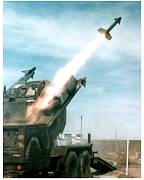
|
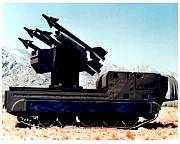
|

|
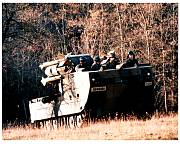
|
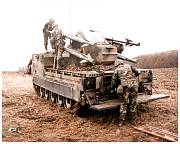
|
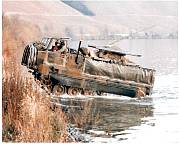
|
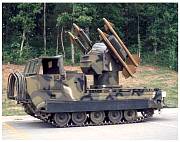
|
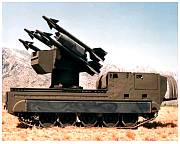
|
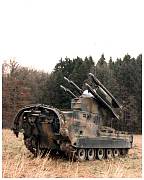
|
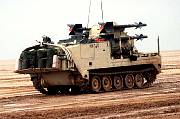
|

|
